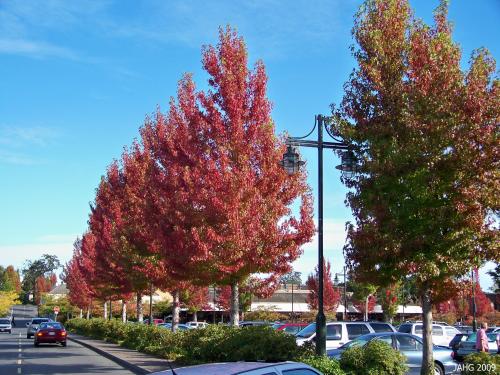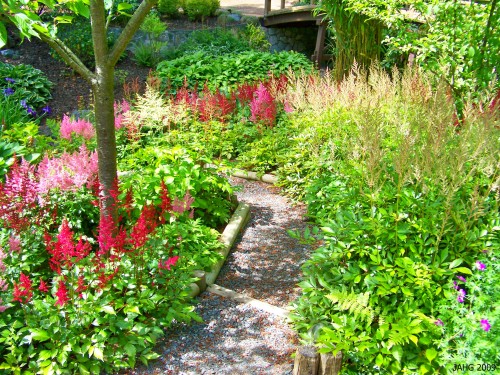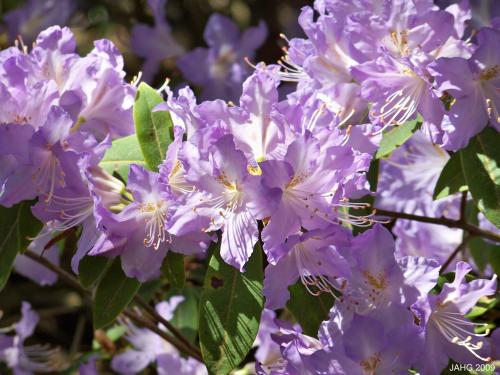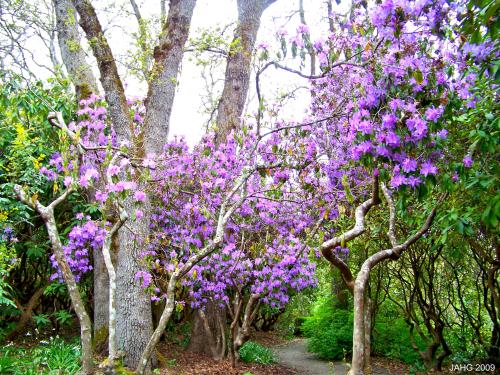Every year this late in the season many of the native trees and shrubs here are suffering from drought conditions and start shedding their leaves. Fall here is drab with dried brownish leaves caused by the dryness. My mother commented on how drab it is here compared to the interior where glorious golden Birch and Poplars color swaths along hills and valleys. Happily there are good plantings in the mot surprising places which are enlivened with the best of fall colors from around the world. One place near me is a big mall which has spectacular shades or orange, peach and reds starting with the Sweet Gum(Liquidambar styraciflua) which provides a backbone of crimson running through the parking lot.

The Sweet Gum trees in Broadmead Village Shopping Centre in Saanich B.C.
We are lucky here that we can grow plants from anywhere in the world. Sweet Gum come from south eastern North America, growing from Connecticut in the north moving west to the very southern edge of Ohio and south to Florida and down through mexico into mountainous areas of Guatemala. They have long been used by the various native groups medicinally. Medicinally the resin(sweet gum or liquid amber) was used as a balm for various ailments but has been found to be not particularly useful. It’s sweet scent has meant it has been used in the as a fragrant adhesive, the manufacture of incense as well as in perfume industry. The resin was collected and used as a chewing gum. At one time the gum was mixed with wild tobacco and smoked at the court of the Mexican emperor.

Liquidambar styrciflua (Sweet Gum) are among collection of trees at the Institute of Ocean Sciences in North Saanich.
Francisco Hernández (1517-1587) was a botanist studied Mexican flora and was the first to write about Sweet Gum trees in his work published in 1651. He wrote about a large tree which produced a fragrant gum which was amber in color. The tree was brought to Europe by John Bannister( a missionary) in 1681 and specimens were planted at Fulham Palace Gardens. At that time it was called Styrax liquida.

The fruit of the Sweet Gum tree is a multi-capsuled bauble which is unpleasant to step on.
One of the main reasons for planting Liquidambar styraciflua is it’s wonderful fall colors. It has a very wide range of shades ranging from a black plum through reds and crimson into oranges and peaches. This quality makes many people long for this tree when they move to other places. There is nothing like seeing the hills dotted with the flaming reds as autumn as it starts to cool off. The leaves of this tree seem to keep their color for extended periods than many others, so we get to enjoy the effect for longer than most other species which drop their leaves quickly after they start to color up.

A crimson bed of Sweet Gum foliage under a crispy brown Red Oak leaf.
Sweet Gums are often mistaken for Maples and they are not. Liqiudambar styraciflua are members of the Witch Hazel family. You can tell they are not maples by their fruit which is a spiky ball. Their leaves are attached to branches in an alternate pattern, whereas Maple leaves are always in opposite pairs. Sweet Gums also have interesting corky twigs which are ditinct from smooth Maple branches.

The very 'Maple-like' leaves of Liquidambar styraciflua.
Sweet Gums do grow to be stately trees of up to 40m (130ft) so placement is important. They tolerate zones 6-10 (-5c and up). They grow best in deep, rich, slightly acid moist soil. These are trees which like wet conditions and often grow in swampy areas. Full sun is a must to get the best color display in autumn. I see these trees used in many places, boulevards, parking lots school yards and other tough places. They are also used as specimens. there are quite a few cultivars (clones) to choose from which give options in hardiness, shape and form, less seedy and color options. There should be one that will fit into any need.

Shades of Liquidambar styraciflua in a pond.
Be sure to be on the look out for Sweet Gum in the coming weeks as the autumn season becomes more pronounced in your area.
More About Liquidambar styraciflua:
Some excellent photographs of the flowers, fruit and bark of Sweet Gum: http://www.duke.edu/~cwcook/trees/list.html
The Institute of Ocean Sciences in North Saanich has good specimens of many trees: http://www.pac.dfo-mpo.gc.ca/science/facilities-installations/ios-ism/index-eng.htm
Description of growing the tree and list of common cultivars(clones) available: http://oregonstate.edu/dept/ldplants/list.htm
In depth description of growing and knowing Sweet Gums:
http://www.hcs.ohio-state.edu/pocketgardener/source/description/li_iflua.html
Until We Meet Again Later…..



















 Stumble It!
Stumble It!






